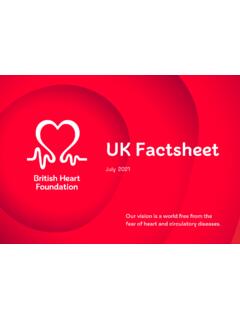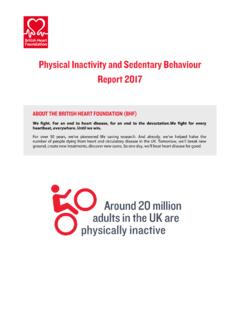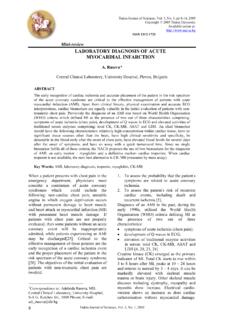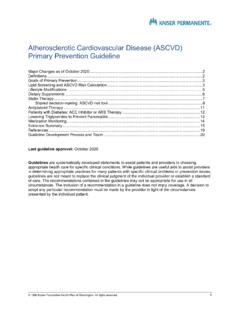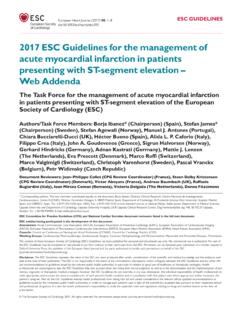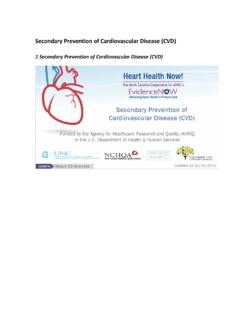Transcription of BHF UK CVD Factsheet - British Heart Foundation
1 Our vision is a world free from the fear of Heart and circulatory diseases. UK Factsheet January 2022 Heart and Circulatory Diseases (Cardiovascular Disease; CVD) Heart and circulatory diseases is an umbrella term for all diseases of the Heart and circulation. It includes everything from conditions that are inherited or that a person is born with, to those that develop later, such as coronary Heart disease, atrial fibrillation, Heart failure, stroke and vascular dementia. There are around million people living with Heart and circulatory diseases in the UK - an ageing and growing population and improved survival rates from Heart and circulatory events could see these numbers rise still further. Around 4 million males and million females are living with Heart and circulatory diseases in the UK. We estimate that in the UK more than half of us will get a Heart or circulatory condition in our lifetime.
2 Around twice as many people are living with Heart and circulatory diseases in the UK than with cancer and Alzheimer s disease combined. Heart and circulatory diseases cause around a quarter of all deaths in the UK; that's more than 160,000 deaths each year, or 460 each day that s one death every three minutes. Around 47,000 people under the age of 75 in the UK die from Heart and circulatory diseases each year. Since the BHF was established the annual number of deaths from Heart and circulatory diseases in the UK has fallen by around a half. In 1961, more than half of all deaths in the UK were attributed to Heart and circulatory diseases (320,000 deaths). Linked conditions Around 80 percent of people with Heart and circulatory diseases have at least one other health condition Figure 1 Deaths from and numbers living with Heart and circulatory diseases (CVD) Deaths - BHF analysis of latest official statistics (ONS/NISRA/NRS); UK total includes non-residents (ONS Nomis data); ICD-10 codes I00-99, F01,Q20-8, , P29, G45 Living with CVD estimates based on latest health surveys with CVD fieldwork and GP patient data.
3 Nation No. of People Dying from CVD (2020) No. of People Under 75 Years Old Dying from CVD (2020) Estimated Number of People Living with CVD (latest) England 137,152 37,353 million Scotland 17,448 5,148 700,000 Wales 9,340 2,762 340,000 Northern Ireland 4,102 1,179 225,000 UNITED KINGDOM (UK) 168,319 46,627 million + Death Rates Death rates take the age structure (demography) of local areas into account to reveal the real differences in statistics. This is very important when there are big variations in the age profile of communities across the UK. Since 1961 the UK death rate from Heart and circulatory diseases (CVD) has declined by more than three quarters. Death rates have fallen more quickly than the actual number of deaths because people in this country are now living longer. The premature (under 75) CVD death rate for Glasgow (134 per 100,000 people) is more than three times than that for Mid Sussex in South East England ( 39 per 100,000) Early deaths from Heart and circulatory diseases (before the age of 75) are most common in the north of England, central Scotland and the south of Wales, and lowest in the south of England.
4 Men All Women Figure 2 Death rates from Heart and circulatory diseases (CVD), UK, 1969 to 2020 Top five UK premature Heart & circulatory disease (CVD) death rates 2018-20 Local Authority Location Under 75 Death Rate per 100,000 People Under 75 Annual Number of CVD Deaths Glasgow City Scotland 606 Blackpool North West England 167 Manchester North West England 357 West Dunbartonshire Scotland 98 Sandwell West Midlands 276 _____ The Cost of Heart and Circulatory Diseases Healthcare costs relating to Heart and circulatory diseases are estimated at 9 billion each year. CVD s cost to the UK economy (including premature death, disability and informal costs) is estimated to be 19 billion each year. UK premature Heart & circulatory disease (CVD) death rate by local authority 201 8-20 For more information please visit: Regional and local statistics Figure 3 Coronary Heart Disease (CHD; IHD; Ischaemic Heart Disease) Coronary Heart disease (CHD) is the most common type of Heart and circulatory disease.
5 It occurs when coronary arteries become narrowed by a build-up of atheroma, a fatty material within their walls. The pain or discomfort felt from such narrowing is called angina and if a blockage occurs it can cause a myocardial infarction ( Heart attack). Key Facts CHD is the one of the UK s leading causes of death and the most common cause of premature death. It was also the leading cause of death worldwide in 2019. CHD is responsible for around 64,000 deaths in the UK each year, an average of 175 people each day, or one death around every eight minutes. In the UK, one in eight men and one in 15 women die from coronary Heart disease. CHD kills twice as many women in the UK as breast cancer. Top 5 UK causes of death (2020) Figure 4 For the top 10 causes of deaths worldwide (2019), see our Global Factsheet Key Facts Around 24,000 people under the age of 75 in the UK die from CHD each year.
6 CHD death rates are highest in Scotland and the north of England. Since the BHF was established the annual number of CHD deaths in the UK has fallen by more than half. There are million people in the UK living with CHD around million men and 830,000 women. UK premature CHD death rate by local authority 201 8-20 Linked conditions People with coronary Heart disease, or who have had a Heart attack, are twice as likely to have a stroke. For more information please visit: Regional and local statistics Coronary Heart Disease Figure 5 Heart Attack ( myocardial Infarction, MI) In the UK as many as 100,000 hospital admissions each year are due to Heart attacks ; that's 280 admissions each day or 1 every 5 minutes. In the 1960s more than 7 out of 10 Heart attacks in the UK were fatal.
7 Today at least 7 out of 10 people survive. It is estimated that around million people alive in the UK today have survived a Heart attack around 1 million men and 380,000 women. _____ Atrial Fibrillation (AF) Atrial fibrillation is one of the most common forms of abnormal Heart rhythm (arrhythmia) and a major cause of stroke. Around million people in the UK have been diagnosed with atrial fibrillation at least 1 in 8 are not treated effectively. It is estimated that there are at least 270,000 people aged over 65 with undiagnosed (or silent) atrial fibrillation in the UK. For more info please visit: Heart attacks Atrial Fibrillation Linked conditions People with AF are five times more likely to have a stroke AF is a contributing factor to one in five strokes Heart Failure Heart failure occurs when the Heart is not pumping blood around the body as well as it should, most commonly when the Heart muscle has been damaged for example, after a Heart attack.
8 Around 650,000 people in the UK are on their GP s Heart failure register. Around 80 per cent of Heart failure diagnoses in England are made in hospital, despite 40 per cent of patients having symptoms that should have triggered an earlier assessment. In total it s estimated that as many as 920,000 people are living with Heart failure in the UK. There are around 200,000 new diagnoses of Heart failure every year in the UK. _____ Stroke (Cerebrovascular Disease; CBVD) A stroke occurs when the blood supply to part of the brain is cut off, causing brain cells to become damaged. A transient ischaemic attack (TIA) is also known as a mini-stroke and is caused by a temporary disruption in the blood supply to part of the brain. Stroke is one of the biggest killers in the UK, causing around 35,000 deaths each year. There are more than 100,000 strokes in the UK each year.
9 That s a stroke at least every 5 minutes. Around million people living in the UK have survived a stroke or transient ischaemic attack (TIA). Around 1 in 4 strokes in the UK occur in people of working age. Stroke is the single biggest cause of severe disability in the UK. Linked conditions People with Heart failure are 2-3 times more likely to have a stroke. People with diabetes are twice as likely to have a stroke. For more info please visit: Heart Failure Stroke Vascular Dementia Vascular dementia happens when there s a problem with the blood supply to an area of your brain. The cells in the affected area of your brain don t get enough oxygen or nutrients and start to die. This leads to symptoms such as concentration problems and personality changes. Vascular dementia causes more than 16,000 deaths each year in the UK numbers could be higher as it can be difficult to diagnose the different types of dementia.
10 Vascular dementia is the second most common type of dementia, seen in around 1 in 4 cases. Vascular dementia is estimated to affect at least 150,000 people in the UK. By 2050 it s predicted that there could be 350,000 people in the UK living with vascular dementia. Linked conditions People with a family history of coronary Heart disease are significantly more likely to develop vascular dementia Vascular dementia accounts for three quarters of dementia cases in stroke survivors People with diabetes are 2-3 times more likely to develop vascular dementia For more info please visit: Vascular dementia Out-of-Hospital Cardiac Arrest (OHCA) Cardiac arrest is a critical medical emergency, where the Heart stops pumping blood around the body. Unless treated immediately, it leads to death within minutes. There are more than 30,000 out-of-hospital cardiac arrests (OHCAs) in the UK each year.
